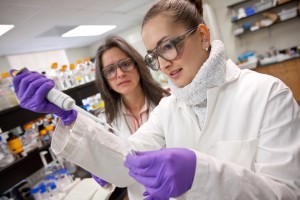Bioactive Signaling Molecules
Participants: Alexander, Comstock, Cramer, Daniel, Furdui, Godwin, Hollis, Johnson, King, Kim-Shapiro, Loeser, Lowther, McPhail, Poole, Salsbury, Torti, Xue
Questions: Researchers in this group use chemical biology (utilizing synthetic probes to discover modification sites in cells) and structural biology (analyzing protein conformation and dynamics) to detect “when and where” particular regulatory modifications take place in proteins and cells, and how the shapes and flexibility of proteins work together to send messages within the cell.

Areas of research focus include the chemical biology of oxygen-, nitrogen- and phosphorus-linked modifications, structures and dynamics of metabolic, signaling and repair proteins, and the structure and function of disease-linked proteins emphasizing cancer, diabetes and arthritis.
Technology: Technology development is a key component of current research in this group; researchers in chemical biology design, synthesize, and test chemical probes that are used within cells to track protein oxidation sites and phosphorylation reactions. Analyses using these probes provide a wide range of information about protein chemistry, structure, and dynamics and require a research environment rich in high-end instrumentation, including imaging, high resolution mass spectrometry (MS), nuclear magnetic resonance spectroscopy, and X-ray crystallography (Fig.1). Facilities exist at WFU to support these activities, particularly within the CSB and the Biology, Biochemistry and Chemistry departments.
Emphasis Group Activities: Several members of the chemical biology group have been involved for more than five years with regular meetings of the Computational network group initiated by Fetrow and Poole between experimental and computational investigators. We will formalize our own “Chemical and Structural Biology” group to meet monthly with presentation of active research from one of the members, emphasizing new technologies and troubleshooting experimental approaches. Activities of this subgroup are organized by Cristina M. Furdui.
Implications: When effective communication networks between cells and their extracellular matrix begin to break down, tissue structures are damaged and disease can ensue. Environmental exposure to various chemicals can change the normal balances of chemical communicators in cells. Thus, the better we can understand the underlying normal biological processes in cells, the better we can piece together what can go wrong when environments change.
